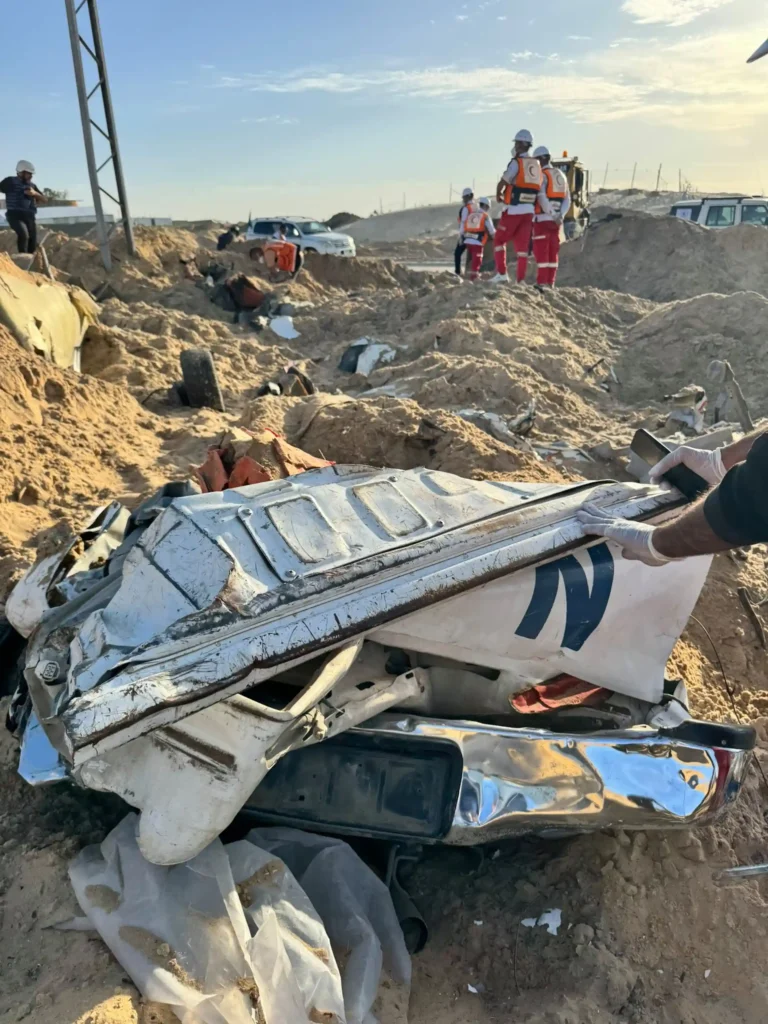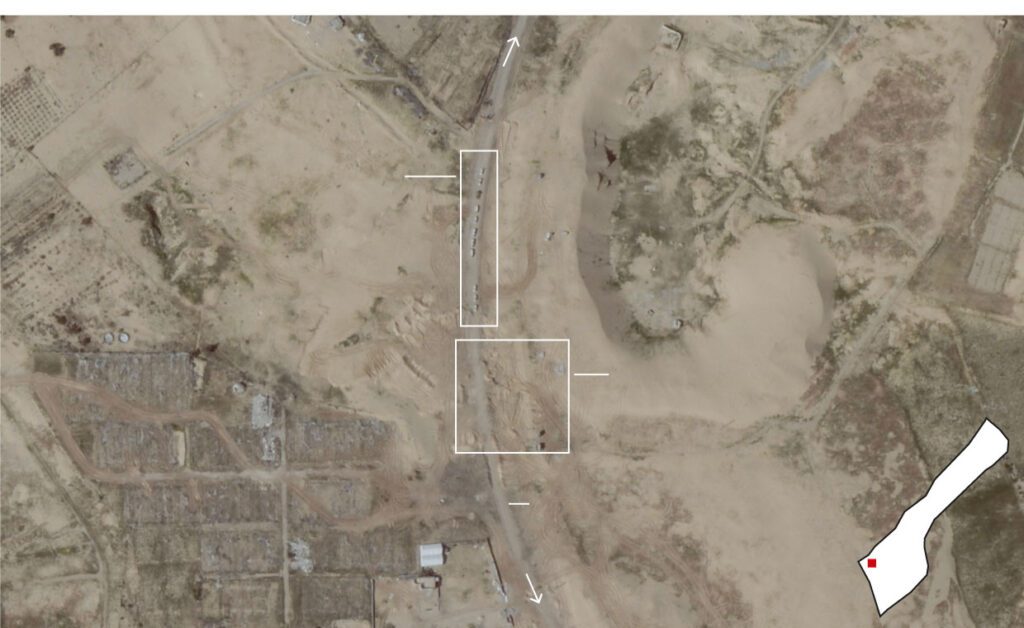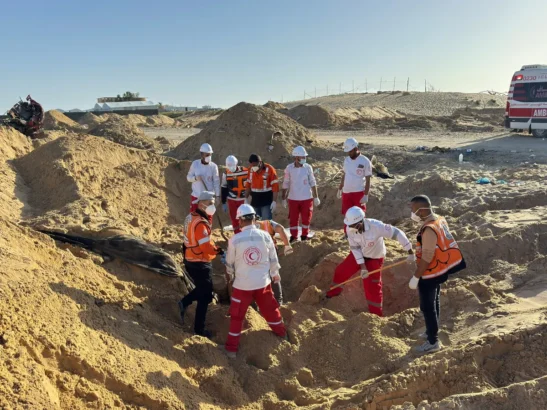On March 23 contact was lost with a team of Palestinian rescue workers and medics in southern Gaza. A week later their bodies were recovered from a mass grave
by Lorenzo Tondo and Malak A Tantesh et al, reposted from The Guardian, April 3, 2025
At 4:20 a.m., a Red Crescent ambulance on its way to collect people injured by an airstrike in Rafah comes under Israeli fire in Hashashin. Two paramedics are killed.
A survivor, Munther Abed, is detained and interrogated. A few hours later, a convoy including ambulances, a fire truck, health ministry vehicles and a UN car is dispatched to recover the bodies of the two paramedics. It also comes under fire. Two health ministry vehicles drive away but contact is lost with the rest of the convoy. Two ambulances sent from Rafah also disappear.

Six days earlier, Israel had ended a two-month-old ceasefire and resumed its military campaign against Hamas and other militant groups in Gaza with heavy aerial bombing and ground operations.
March 24
Gaza’s civil defense agency says it has not heard from the missing people. Access to the site is blocked by the Israel Defense Forces (IDF).
March 26
A convoy of vehicles carrying officials from the United Nations Office for the Coordination of Humanitarian Affairs (OCHA) tries and fails to access the site. While en route, the OCHA team see a woman being shot, the bullet hitting her in the back of the head, and a man who is trying to retrieve her also being shot. The woman’s body is recovered and put into a UN vehicle.
Video: OCHA convoys try to access mass burial site
March 27
The OCHA team finally make it to the site. They report finding the ambulances, the UN vehicle and the fire truck crushed and partially buried. The body of a civil defense worker is recovered from under the fire truck, but the recovery mission has to withdraw as the situation becomes unsafe.
Video: Ambulances and UN vehicle excavated from the sand
March 28
The civil defense agency says it has accessed the site and found the body of its team leader there, as well as an ambulance and the Red Crescent’s fire truck, which it says has been “reduced to a pile of scrap metal.”
March 30
OCHA officials and Red Crescent workers return to the site and find the bodies of eight Red Crescent workers, the five other civil defense responders and one UN staff member buried in a mass grave. A ninth Red Crescent worker remains unaccounted for.
Video: Bodies of health workers pulled from the burial site
The crushed UN vehicle and the fire truck can be seen in photographs taken at the scene.



In a video filmed at the scene, Jonathan Whittall, the head of OCHA in Palestine, says the dead were shot “one by one” then buried in a mass grave.
Video: ‘Health workers should never be a target’: Head of OCHA describes scene
MARCH 31
The burials are postponed pending autopsies. The head of OCHA, Tom Fletcher, says the dead were found buried by their wrecked and well-marked vehicles. “They were killed by Israeli forces while trying to save lives,” Fletcher says. “We demand answers and justice.”
The IDF claims its soldiers opened fire on the vehicles because they were “advancing suspiciously toward IDF troops without headlights or emergency signals” and alleges, without providing evidence, that Hamas and Islamic Jihad militants were among those killed. None were reported to be in the mass grave.
April 1
Two witnesses tell the Guardian that some of the bodies recovered from the grave had had their hands or feet tied, suggesting they were shot after being detained. A Red Crescent official says Israeli soldiers could be heard – over a phone line that was open to one of the paramedics at the time of the convoy shooting – ordering restraints to detain apparent survivors from the convoy.
April 2
A forensics consultant who examined five of the bodies says there is evidence of execution-style killing in some cases based on the “specific and intentional” location of shots taken at close range. The UK foreign secretary, David Lammy, says Gaza has become the world’s most dangerous place for humanitarian workers and calls for those responsible for the killings to be held accountable.
April 3
The Israeli military says it is investigating the killings. It maintains that “terrorists” were advancing in the ambulances.
Abed, the survivor, tells the Guardian he was detained and beaten and had to watch as one ambulance and rescue vehicle after another approached the scene and came under intense gunfire. He says he witnessed the wreckage being buried by military bulldozers, and that he saw the missing Red Crescent worker, Assad al-Nassara, alive and in Israeli detention. After several hours of Israeli interrogation Abed was released and left to walk homewards.
Lorenzo Tondo is a Guardian correspondent covering Italy and the migration crisis.
Malak A Tantesh, in Jerusalem, is a reporter based in Gaza.
Julian Borger is the Guardian’s senior international correspondent based in London. He was previously a correspondent in the US, the Middle East, eastern Europe and the Balkans. He is the author of two books.
Bryony Moore is a Guardian multimedia journalist.
Tural Ahmedzade is deputy news graphics editor at the Guardian.
RELATED ARTICLES:
- ‘Every Atrocity Imaginable’: Litany of Israeli War Crimes Continues
- ‘No Civilians’: IDF Soldiers Reveal Killings, Lawlessness in Gaza
- 18 March 2025: The day 183 children in Gaza were massacred by Israel
- On the frontlines of hell: Testimonies from Gaza’s doctors
- Doctors in Gaza Say They Have No Doubt Israel Is Targeting Them
- Inside Israel’s ‘torture’ jails where Palestinians held without charge tell of brutal treatment
- Palestinian Prisoners: Harrowing Reports Of Systemic Torture – 2 articles
- The U.S. has become a two-tier country: Israel partisans on top





